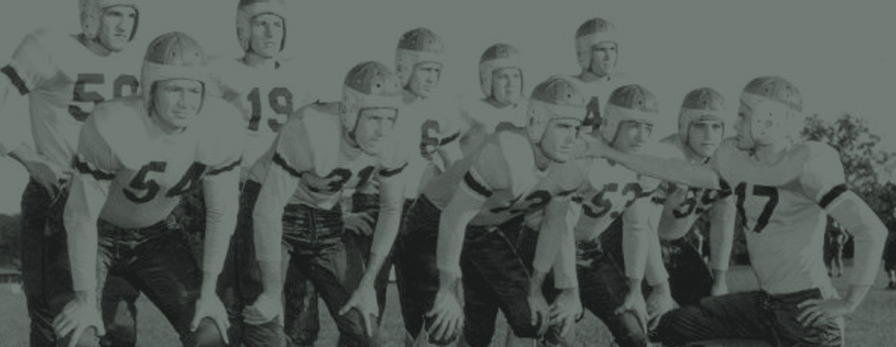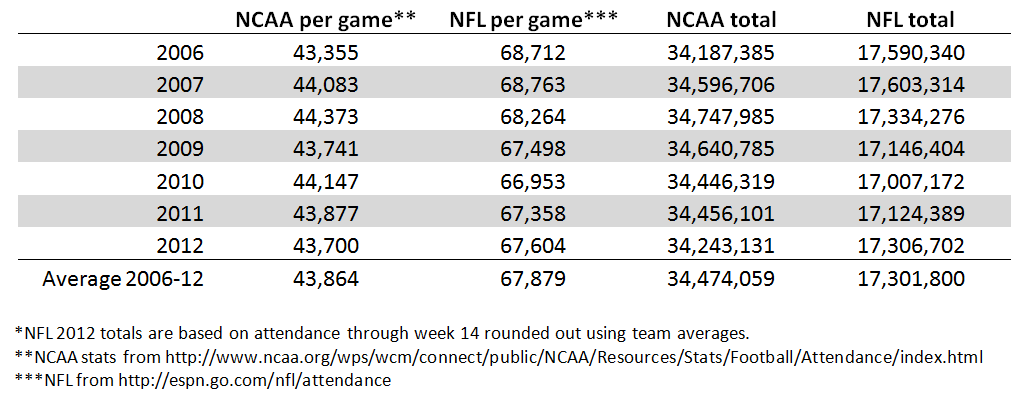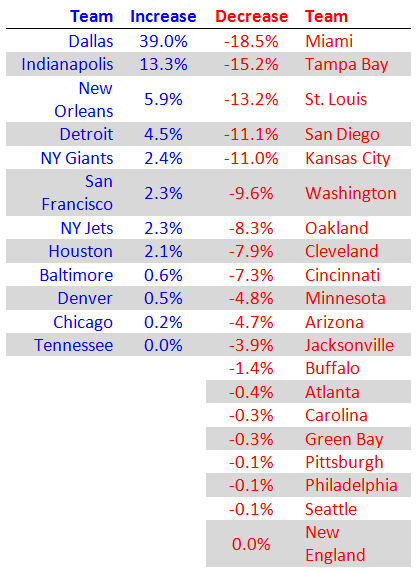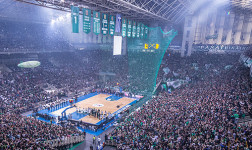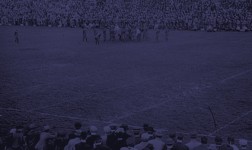Big screen TVs, stereo surround sound, Sunday Ticket and RedZone programming, cheap food and drinks. With the NFL and College Football game-viewing experience in fans’ homes becoming more comfortable, elaborate, and engaged, there is concern in some quarters that the fan experience at the stadiums is not competitive anymore. 1 Let’s consider the “attendance is dropping” sentiment on relative terms – NCAA attendance compared to that of the NFL.
Specifically, we analyzed home attendance numbers in the NFL and NCAA Division I FBS from 2006 to 2012, excluding preseason, playoff, and bowl games. Here’s what we found:
The average attendance per game is higher in the NFL than in the NCAA, but since there are nearly four times as many NCAA D-I teams, they pull in more fans overall. Using 2006 as a baseline, both the NCAA and NFL look relatively similar in 2012 as they did six years ago. So as a whole, attendance has remained stable, but when we break things down a bit more and start to look at individual teams, we find more compelling story lines.
The swing in average-game attendance per year is about four times higher in the NCAA than in the NFL, showing that the college world is inherently more variable when it comes to fan attendance. At the same time, the number of teams on either side of the increase/decrease line is roughly equal – just over half (62 vs 57) of the teams increased attendance between 2006 and 2012, and just under half saw a decrease.
For the six seasons we examined, between 52 and 61 NCAA teams saw an increase in attendance, and between 54 and 66 teams saw a decrease, for a total of 340 increases and 363 decreases. So even though individual teams saw big swings in home game attendance over the course of any given year, the NCAA as a whole has been relatively stable.
The story in the NFL isn’t as positive. Nearly two-thirds of NFL teams lost attendance over the years in question, while just over one-third saw an increase. NFL teams saw an increase in attendance 77 times and a decrease in attendance 97 times, nearly the same as the -23 difference of the NCAA, but with just a quarter of the teams. So while the NFL’s attendance is more stable year-to-year, there are twice as many teams on a downward trajectory, hurting the league as a whole.
Something else we have to take into account are teams that have moved into new stadiums in the last six years. Four of those 11 NFL teams that increased attendance opened new stadiums since 2006, including the two that have increased attendance the most, and this accounts for the bulk of the NFL’s attendance gains.
Excluding these teams, the average attendance decreases from -1,108 per team per game, to -2,549 per team per game. Nine of the ten largest changes in attendance from 2006-12 were decreases.
But while building a new stadium might help attendance in the NFL, the effect in college is negligible. 2 Here are the NCAA teams that have opened a new stadium in the last six years:
As you can see, there’s an initial bump from the new stadium in all cases, but nowhere near as much as there was with Dallas. In two of the cases, Minnesota and Akron, their decrease in fans could be partially attributed to the fact that their new stadiums have a smaller capacity than their old ones. In the case of the other three, Central Florida is now averaging less than 10% more than they were in 2006, North Texas is attracting just a few hundred more than they did in 2009 at their old stadium, and Florida Atlantic’s attendance in 2012 was its lowest since 2006.
So looking at the big picture, neither the NFL nor the NCAA are in dire straits regarding attendance at games – crowds might not be growing exponentially, but the leagues are also not hemorrhaging fans. And, as attendance is linked to price (ticket as well as ancillaries like parking & concessions) as components of revenue, a moderate decrease in attendance in conjunction with increased ticket prices might be revenue neutral or possibly revenue positive, depending on the specific numbers. 3
When one examines team-level attendance, as individual ADs and NFL owners do, some teams are losing fans (or those fans are staying home to watch the games), and for those contingents the attempts to fill the seats, by employing ever more novel and sophisticated in-stadium experiences, will continue. 4
Key Insights
We considered the “attendance is dropping” sentiment on relative terms – NCAA attendance compared to that of the NFL. We analyzed home attendance numbers in the NFL and NCAA Division I FBS from 2006 to 2012, excluding preseason, playoff, and bowl games and found that neither the NFL nor the NCAA are in dire straits regarding attendance at games – crowds might not be growing exponentially, but the leagues are also not hemorrhaging fans.
References:
- Examples of college and NFL teams enhancing the stadium experience include: HD video boards, improved cell phone reception to allow fans to more effectively use their mobile devices, and even allowing fans to bring tablets and lap tops into games. http://www.postandcourier.com/article/20121223/PC20/121229695/college-football-ads-face-a-challenge-attendance-is-on-the-decline-and-tv-might-be-keeping-fans-away ↩
- A new study also looked at whether building a new stadium increased competitiveness in Major League Baseball and found no correlation between new facilities and competitiveness. Even increases in revenue often associated with a new stadium usually reverted to previous levels after only three or four years. http://chance.amstat.org/2012/11/stadiums/ ↩
- http://winthropintelligence.com/2012/06/18/measuring-scope-effectiveness-outbound-ticket-sales-teams-ncaa-division-i-athletic-departments/ ↩
- A visual comparison of NFL stadium screens: http://flowingdata.com/2012/12/27/nfl-video-screen-compared ↩

